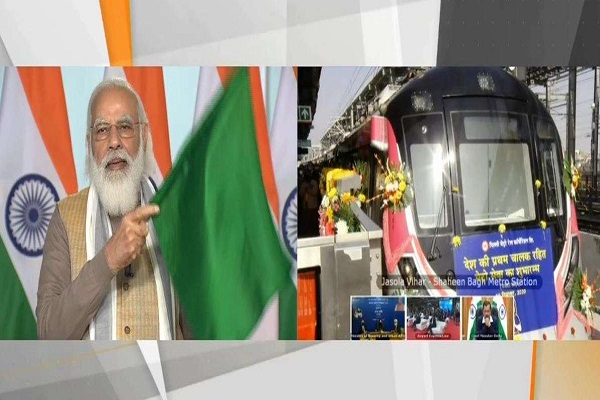
In a significant leap make urban development future-ready and placing a new benchmark of growth and development, Prime Minister Narendra Modi inaugurated India’s first-ever driverless metro train on Delhi Metro Rail Corporation’s (DMRC) Magenta Line on December 28 via video conferencing. The PM also announced the expansion of National Common Mobility Card to the Airport Express Line of Delhi Metro. Union Minister of State for Housing and Urban Affairs, Hardeep Singh Puri and Chief Minister of Delhi, Arvind Kejriwal were also present on the occasion.
Addressing the occasion, PM Modi termed the inaugural event as an attempt to make urban development future-ready. He said preparing the country for future needs is an important responsibility of governance. He lamented the fact that a few decades ago, when the demand of urbanisation was felt, there was not much attention given to the needs of the future, half-hearted work was done and confusion persisted. Unlike this, modern thinking says that urbanisation should not be seen as a challenge but used as an opportunity to build better infrastructure in the country, an opportunity through which we can enhance Ease of Living. This difference of thinking is seen now in every dimension of urbanization, added the PM.
In 2014, only 5 cities had metro rail service and today, metro rail is available in 18 cities. By the year 2025, we are going to expand it to more than 25 cities. Today the metro covers over 700 km of distance which is thrice more than the 248 km of coverage in 2014. By the year 2025, we are trying to expand it to 1700 km said PM Modi.

The Prime Minister remarked that the government formulated the metro policy for the first time and implemented it with an all-round strategy. Emphasis was on working according to local demand, promoting local standards, Make in India expansion and use of modern technology. He said it was noted that the expansion of the metro, modern modes of transport should be used according to the needs of the people of the city and the professional lifestyle there. This is the reason why work is being done on different types of metro rail in different cities.
Also Read: Delhi Metro Launches ‘Autope’ – Auto Top-up Travel Card

Listing out the different types of metro rail works being carried out, PM Modi said, on the Regional Rapid Transit System (RRTS) between Delhi and Meerut will reduce the distance of Delhi and Meerut to less than an hour. He said in cities where passenger numbers are less, work is being done on the MetroLite version. MetroLite version would be constructed at 40 per cent cost of normal metro. He further added that Metro Neo is being worked in cities where the ridership is less. It would be built at the cost of 25 per cent of the normal metro. Similarly, water metro would be an out of the box thinking. For cities where there are large water bodies, the water metro is now being worked on. This will provide last-mile connectivity to the people near the islands.
The PM said the metro today is no longer just a medium of public transport but a great way to reduce pollution. Thousands of vehicles have been reduced from the road due to the metro network, which used to cause pollution and traffic jams.
Further, he said that for the expansion of metro services, Make in India is important. Make in India reduces costs, saves foreign exchange, and gives more employment to people in the country itself. He stressed that standardisation of rolling stock has reduced the cost of every coach from Rs 12 crore to Rs 8 crore now. Today, four big companies are manufacturing metro coaches in the country and dozens of companies are engaged in the manufacturing of metro components. This is helping Make in India as well as the campaign for self-reliant India.
With the achievement of driverless metro rail, our country has joined the select countries of the world where such facilities are available. He said a braking system in which 50 per cent of the energy goes back into the grid when the brakes are applied are being used. Today 130 MW of solar power is being used in metro rail, which will be increased to 600 MW.
Also Read: Agra Metro Project: Major Boost to Economic Sector of Heritage City
Speaking on the Common Mobility Card, the PM said that providing the same standards and facilities for modernisation is very important. The Common Mobility Card at the national level is a major step in this direction. This one card will give integrated access to the commuters wherever they travel, whichever public transport they take. With this, he dwelled on the process of consolidating all the systems. Through such consolidation of systems, the strength of the country is being harnessed in a more coordinated and efficient way.
(With inputs from PIB)
Be a part of Elets Collaborative Initiatives. Join Us for Upcoming Events and explore business opportunities. Like us on Facebook , connect with us on LinkedIn and follow us on Twitter, Instagram.











